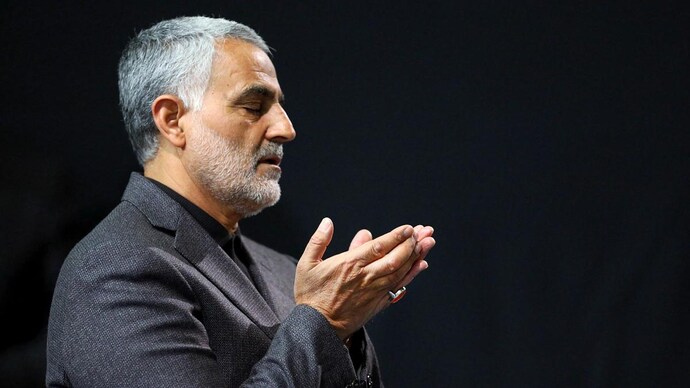General Soleimani had helped US upstage Taliban in Afghanistan post-9/11
Iraqis had dubbed General Soleimani as "the goat thief" during Iran-Iraq war. He had helped the US with specific intelligence about Taliban forces after 9/11. But he was soon to be declared an enemy national by the US.

General Qassem Soleimani had an envious resume for a clandestine operative. He was the man, many believed in Iran, whom country's supreme leader Ali Khamenei was preparing as his successor. Days after Iran-backed Shia militia entered the US embassy in Iraq, US President ordered Soleimani's killing.
Deaths of Soleimani and Abu Mahdi al-Muhandis, the leader of Kataib Hezbollah - a constituent of the Popular Mobilisation Forces (PMF), comprising of 40 Shiite militia groups in Iraq - and the US's role behind the killings have been confirmed by both the US and Iran.
General Soleimani was a cult figure in Iran and the most visible face on Iranian news television. Before turning an enemy of the US, Soleimani played key role in the American success in Afghanistan in the aftermath of 9/11 terror attacks in America.
The September 11 aerial attacks using passenger planes to target key US installations in 2001 had left the US and the world shocked and in fear of terrorist outfit, Al-Qaeda. Its leader Osama bin Laden was operating from Afghanistan, which was under the rule of Taliban-another fundamentalist terror outfit with political ambitions.
The US was looking for actionable intelligence against Al-Qaeda for which it needed to fight Taliban and restore a civilian government in the country. Attacking another country was, though not surprising for the US in the backdrop of the Iraq experience, but it required an actionable intelligence to work as a solid reason and a concrete plan. Both came the US's way in late 2001 courtesy Qassem Soleimani, the head of Quds Forces.
Quds literally means holy. In Persian Quds is a reference to Jerusalem, a city claimed by the Jews, the Christians and the Muslims.
Creation of Quds Forces was a defining moment of the Iranian Islamic Revolution that began in 1979 and continued for few years before then supreme leader Ayatollah Kohmeini took complete control of Iran.
Quds Forces is an equivalent to an amalgamation of the Central Intelligence Agency (CIA) and Special Forces of the US. Quds Forces is the foreign intelligence and clandestine military operation wing of the Iran's Revolutionary Guards Corps. It has its influence not only in West Asia - where Hezbollah is its fiercest protégé - but even beyond up to Thailand and Latin America.
Soleimani had risen to prominence in Iran during the Iran-Iraq war (1980-88). He was part of a special force and registered many victories over the forces of Saddam Hussein of Iraq. After victories in many battles, Soleimani would return carrying a goat on his shoulders prompting the Iraqis to dub him as "the goat thief".
This goat thief became head of the Quds Forces in 1998. Three years later, when Al-Qaeda terrorists hijacked five planes in America and crashed them to selected targets, Soleiman was in complete control of regional intelligence.
Though the US and Iran did not have a diplomatic relation after 1980, this did not stop Soleimani to cooperate with the US, when it sought assistance against Taliban and Al-Qaeda.
The US wanted to punish the perpetrators of 9/11 while Soleimani wished to punish Taliban because they had targeted Shia Afghans.
A series of meetings between the US officials and negotiators named by Soleimani was held, beginning with the one in Geneva days after 9/11 attacks. By the start of October 2001, Soleimani was said to have got irritated with the delay in US attacks on Taliban.
In one of the meetings in early October 2001, Soleimani's negotiators "threw" a map at the US officials telling them "attack here first", "attack there then" and "attack here next". The US officials kept the map, and on October 7 bombings began on Taliban installations.
In three years' time, a US-backed government took over the reins of power in Afghanistan though Taliban continued to exert pressure in certain areas of the country. During these years, Osama bin Laden fled Afghanistan and took refuge in Pakistan. In 2011, the US commandos killed Osama bin Laden in a special operation in Pakistan's garrison town Abbottabad.
Soleiman had the credit to show the US forces a pathway to take on Taliban and Al-Qaeda. However, only three months after the US began bombing on Taliban, then President George Bush clubbed Iran in the axis of evil, turning Soleiman an enemy of the US.
In April 2019, the Trump administration declared Iranian Revolutionary Guard and Quds Forces terrorist outfits calling for action against people associated with the forces.
Curiously, the order to kill Qassem Soleimani came, the Pentagon has said, from US President Donald Trump. This has come at a time when Trump is facing impeachment. The House of Representatives has impeached him and process is under for a trial in the Senate.
